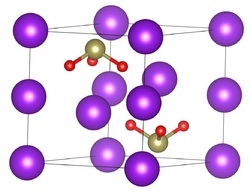Chemistry:Potassium tellurite
From HandWiki

| |
| Identifiers | |
|---|---|
3D model (JSmol)
|
|
| ChEBI | |
| ChemSpider | |
| EC Number |
|
PubChem CID
|
|
| UNII | |
| |
| |
| Properties | |
| K2TeO3 | |
| Appearance | white crystals, powder |
| Hazards | |
| GHS pictograms |  
|
| GHS Signal word | Danger |
| H301, H315, H319, H335 | |
| P261, P264, P270, P271, P280, P301+310, P302+352, P304+340, P305+351+338, P312, P321, P330, P332+313, P337+313, P362, P403+233, P405, P501 | |
Except where otherwise noted, data are given for materials in their standard state (at 25 °C [77 °F], 100 kPa). | |
| Infobox references | |
Tracking categories (test):
Potassium tellurite, K2TeO3, is an inorganic potassium-tellurium compound.[1] It has been used as a selective growth medium in microbiology.[2][3][4][5]
References
- ↑ "Potassium tellurite". https://www.sigmaaldrich.com/catalog/product/aldrich/p0677. Retrieved 24 December 2018.
- ↑ Gilbert, R; Humphreys, EM (February 1926). "The Use of Potassium Tellurite in Differential Media". Journal of Bacteriology 11 (2): 141–51. PMID 16559175.
- ↑ Advances in Microbial Physiology. Elsevier. 6 September 2007. p. 27. ISBN 978-0-08-056064-9. https://books.google.com/books?id=1G95oJ1JONIC&pg=PA27.
- ↑ J.E.L. Corry; G.D.W. Curtis; Rosamund M. Baird (6 May 2003). Handbook of Culture Media for Food Microbiology, Second Edition. Elsevier. p. 95. ISBN 978-0-444-51084-6. https://books.google.com/books?id=N1PtUwDrFGQC&pg=PA95.
- ↑ Elliot T. Ryser; Elmer H. Marth (27 March 2007). Listeria, Listeriosis, and Food Safety. CRC Press. pp. 219–220. ISBN 978-1-4200-1518-8. https://books.google.com/books?id=NZsS6tbSAFYC&pg=PA219.
 |

